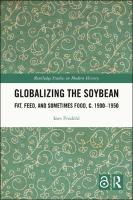Globalizing the Soybean
Proposal review
Fat, Feed, and Sometimes Food, c. 1900–1950
Abstract
Globalizing the Soybean asks how the soybean conquered the West and analyzes why and how the crop gained entry into agriculture and industry in regions beyond Asia in the first half of the twentieth century.
Historian Ines Prodöhl describes the soybean’s journey centered on three hubs: Northeast China, as the crop’s main growing area up to the Second World War; Germany, to where most of the beans in the interwar period were shipped; and the United States, which became the leading cultivator of soy worldwide during the 1940s. This book explores the German and U.S. adoption of the soybean being closely tied to global economic and political changes, such as the two world wars and the Great Depression. The attraction of the soybean to stakeholders on both sides of the Atlantic was linked to a need for cheap alternatives to butter and lard and a desire for greater quantities of meat, which led to the soybean becoming a cheap resource for fat and fodder. Only occasionally was it also used as food.
This volume is useful for anyone who is studying or interested in economic history and commodity trading in the twentieth century. It is also connected to the histories of capitalism, globalization, imperialism, and materiality.
Keywords
History, Science, Global, InternationalDOI
10.4324/9781003255222ISBN
9781032185767, 9781032185798, 9781003255222, 9781000877342Publisher
Taylor & FrancisPublisher website
https://taylorandfrancis.com/Publication date and place
2023Grantor
Imprint
RoutledgeSeries
Routledge Studies in Modern History,Classification
History
Asian history
European history
History of the Americas
General and world history


 Download
Download